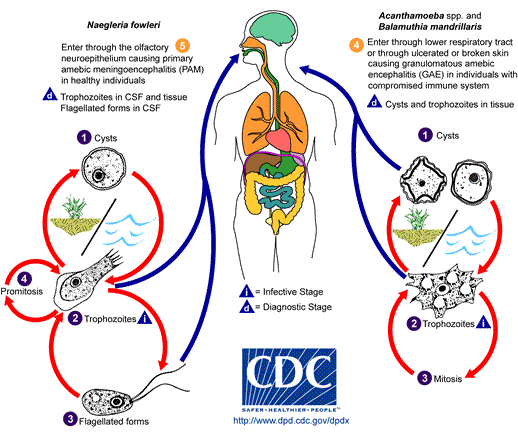| |
Free-living amebae
belonging to the genera Acanthamoeba, Balamuthia, and
Naegleria are important causes of disease in humans and animals.
Naegleria fowleri produces an acute, and usually lethal, central nervous
system (CNS) disease called primary amebic meingoencephalitis (PAM). N.
fowleri has three stages, cysts
 ,
trophozoites ,
trophozoites
 , and
flagellated forms , and
flagellated forms
 , in its
life cycle. The trophozoites replicate by promitosis (nuclear membrane
remains intact) , in its
life cycle. The trophozoites replicate by promitosis (nuclear membrane
remains intact)
 .
Naegleria fowleri is found in fresh water, soil, thermal discharges of
power plants, heated swimming pools, hydrotherapy and medicinal pools,
aquariums, and sewage. Trophozoites can turn into temporary flagellated
forms which usually revert back to the trophozoite stage. Trophozoites
infect humans or animals by entering the olfactory neuroepithelium .
Naegleria fowleri is found in fresh water, soil, thermal discharges of
power plants, heated swimming pools, hydrotherapy and medicinal pools,
aquariums, and sewage. Trophozoites can turn into temporary flagellated
forms which usually revert back to the trophozoite stage. Trophozoites
infect humans or animals by entering the olfactory neuroepithelium
 and
reaching the brain. N. fowleri trophozoites are found in
cerebrospinal fluid (CSF) and tissue, while flagellated forms are found in
CSF. and
reaching the brain. N. fowleri trophozoites are found in
cerebrospinal fluid (CSF) and tissue, while flagellated forms are found in
CSF.
Acanthamoeba spp. and
Balamuthia mandrillaris are opportunistic free-living amebae capable of
causing granulomatous amebic encephalitis (GAE) in individuals with
compromised immune systems. Acanthamoeba spp. have been found in
soil; fresh, brackish, and sea water; sewage; swimming pools; contact lens
equipment; medicinal pools; dental treatment units; dialysis machines;
heating, ventilating, and air conditioning systems; mammalian cell cultures;
vegetables; human nostrils and throats; and human and animal brain, skin,
and lung tissues. B. mandrillaris however, has not been isolated
from the environment but has been isolated from autopsy specimens of
infected humans and animals. Unlike N. fowleri, Acanthamoeba
and Balamuthia have only two stages, cysts
 and
trophozoites and
trophozoites
 , in
their life cycle. No flagellated stage exists as part of the life cycle.
The trophozoites replicate by mitosis (nuclear membrane does not remain
intact) , in
their life cycle. No flagellated stage exists as part of the life cycle.
The trophozoites replicate by mitosis (nuclear membrane does not remain
intact)  .
The trophozoites are the infective forms and are believed to gain entry into
the body through the lower respiratory tract, ulcerated or broken skin and
invade the central nervous system by hematogenous dissemination .
The trophozoites are the infective forms and are believed to gain entry into
the body through the lower respiratory tract, ulcerated or broken skin and
invade the central nervous system by hematogenous dissemination
 .
Acanthamoeba spp. and Balamuthia mandrillaris cysts and
trophozoites are found in tissue. .
Acanthamoeba spp. and Balamuthia mandrillaris cysts and
trophozoites are found in tissue. |
|
